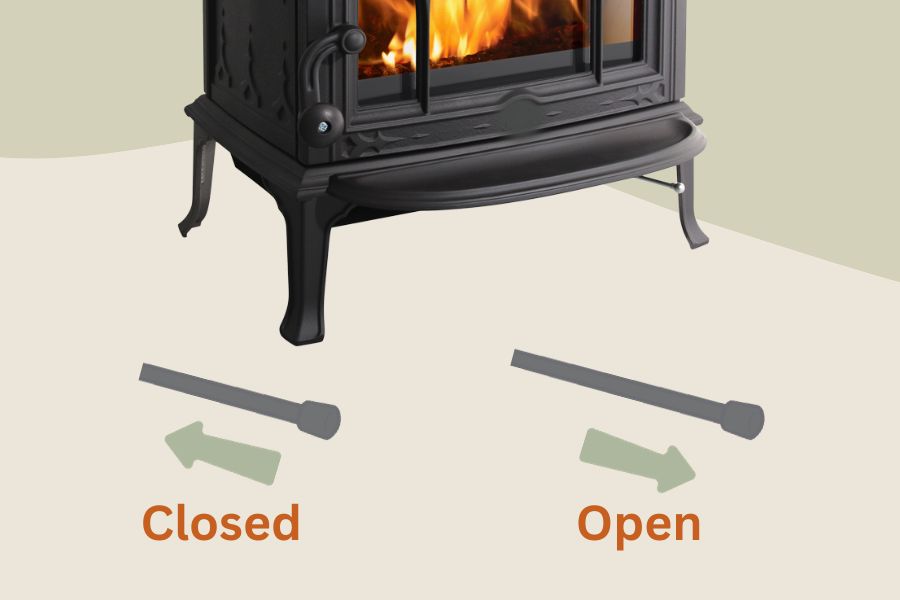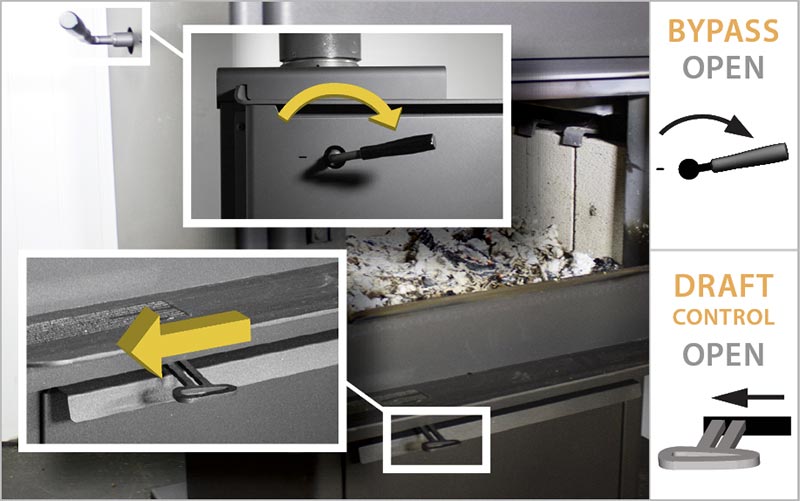To maximize heat from a wood burner, keep the primary air vent open initially. Once the fire is burning well, adjust by closing the primary vent and using the secondary vent for airflow control.
Proper vent management ensures efficient burning and heat output. Learn when and how to adjust wood burner vents for optimal performance. Mastering the art of vent regulation will enhance your wood burning experience, providing warmth and comfort while minimizing fuel consumption.
By understanding the role of primary and secondary vents, you can effectively manage airflow and create a cozy ambiance with your wood burner. Properly managing your wood burner vents can make a significant difference in the efficiency and longevity of your fire.


Credit: www.wikihow.com
Understanding Wood Burner Vents
In a wood burner, the air supply system plays a crucial role in controlling the combustion process. The primary air vent is responsible for initiating the fire, while the secondary air vent helps regulate the burn rate.
The tertiary air supply, often overlooked, can significantly impact the efficiency of the firebox. By introducing tertiary air, you can enhance combustion and reduce emissions, leading to a cleaner and more effective burn.
- Primary air vent initiates the fire
- Secondary air vent regulates burn rate
- Tertiary air supply improves efficiency and reduces emissions
Controlling the vents on a wood burner is crucial for maintaining optimal combustion and heat output. By understanding how the air supply system works and utilizing tertiary air effectively, you can maximize the performance of your wood burner.

Credit: blog.gr8fires.co.uk
Lighting And Maintaining A Wood Stove Fire
Before starting a fire in your wood stove, understanding the correct techniques for lighting and maintaining it is crucial for optimal performance.
Adding Larger Pieces Of Wood
When adding larger pieces of wood to your wood stove, ensure they are dry and seasoned to encourage efficient burning.
Adjusting The Damper
Adjusting the damper plays a key role in controlling the airflow and heat output of your wood stove. Open the damper fully when starting the fire, and gradually adjust it as needed to maintain a steady burn.
“` This HTML section provides valuable insights on ‘Lighting and Maintaining a Wood Stove Fire,’ with specific details on ‘Adding Larger Pieces of Wood’ and ‘Adjusting the Damper’ for efficient wood stove operation.Using A Wood Burning Stove
When building a fire in a wood burning stove, it’s important to start with small pieces of kindling arranged in a crisscross pattern to allow for optimal airflow.
Once the fire is burning, adjusting the damper is crucial to controlling the airflow within the stove. Closing the damper slightly after the fire catches helps in reducing the air flow and preventing the fire from burning too quickly. You can then use the secondary air vent to regulate the airflow and maintain the desired heat level.
Before leaving a wood burning stove unattended, ensure that the vents are closed to prevent overheating and the risk of a potential fire hazard.
Maximizing Heat From A Log Burner
To maximize heat from a log burner, start with the primary air vent open to get the fire going. Once the fire is burning well, gradually close the primary vent and use the secondary vent to control the airflow, which plays a crucial part in optimizing heat output.
Controlling Air Flow Using Primary And Secondary Air Vents
To maximize the heat from your log burner, it is crucial to understand how to control the air flow. This can be achieved by properly adjusting the primary and secondary air vents. The primary air vent, located at the bottom of the stove, is responsible for getting the fire started. When lighting your log burner, keep the primary air vent fully open to provide enough oxygen for combustion. Once the fire catches and the kindling is burning, you can start adjusting the air flow by gradually closing the primary air vent. This will reduce the amount of oxygen entering the firebox, resulting in a slower burn rate and more efficient heat generation. It’s important to find the right balance between air flow and heat output, so experiment with partially closing the primary air vent until you achieve the desired heat level. Now, let’s talk about the secondary air vent. Positioned at the top of the stove, this vent allows for further control over the air flow. While the primary air vent focuses on providing oxygen for combustion, the secondary air vent helps in regulating the intensity of the flame. By adjusting the secondary air vent, you can fine-tune the burn rate and optimize heat production according to your preferences.Adjusting The Grate In Wood Burning Stove
Another aspect to consider when maximizing heat from a log burner is the position of the grate in your wood-burning stove. The grate plays a crucial role in ensuring proper airflow underneath the fire and efficient combustion. Generally, the grate should be positioned closer to the front of the stove, allowing for better control over the fire’s intensity. This placement helps create a hotter zone near the front of the stove, where logs can burn and produce more heat. Moreover, it prevents logs from rolling forward and obstructing the airflow. However, it’s essential to strike a balance between maximizing heat output and ensuring a clean burn. If you notice excessive smoke or a smoldering fire, it may indicate that the grate is positioned too close to the front. In such cases, try adjusting the grate slightly towards the back for a more efficient burn. Remember, every wood-burning stove is unique, so it may require some experimentation to find the optimal position for your grate. Regularly inspect the fire and make adjustments as necessary to achieve maximum heat output from your log burner. In conclusion, to maximize the heat generated by your log burner, focus on controlling the air flow through the use of primary and secondary air vents. Adjusting the primary air vent, primarily during the initial stages of lighting the fire, helps regulate the burn rate. Meanwhile, fine-tuning the flame intensity can be achieved by manipulating the secondary air vent. Additionally, paying attention to the position of the grate in your wood-burning stove ensures efficient combustion and helps achieve an optimal balance between heat output and clean burn.Effect Of Vents On Wood Burner Performance
To optimize wood burner performance, adjust vents accordingly. Keep primary air vent open for ignition, then gradually close it while utilizing secondary vent for airflow control. Proper vent management enhances heat efficiency and fuel consumption in wood burning stoves.
Restricting Air Supply By Closing Vents
When it comes to wood burner performance, one crucial factor to consider is the effect of vents on the overall operation of the stove. The vents play a significant role in controlling the air supply to the fire, which ultimately affects heat and smoke output. Specifically, the practice of closing vents can have a noticeable impact on the functioning of a wood burner.
Impact On Heat And Smoke Output
By restricting the air supply to the fire by closing the vents, you can effectively regulate the heat generated by the wood burner. When the vents are opened, more air flows into the firebox, leading to a higher combustion rate and increased heat output. On the other hand, closing the vents reduces the amount of oxygen available for combustion, resulting in a slower burn and lower heat output.
Closing the vents can also impact the smoke output of the wood burner. When the vents are fully open, ample air supply promotes efficient combustion, leading to cleaner and less smoky fires. However, by partially or completely closing the vents, the reduced airflow can result in incomplete combustion, leading to more smoke production. It’s important to find the right balance between vent adjustments to achieve optimum heat output and minimal smoke production.

Credit: www.regency-fire.com
Frequently Asked Questions For Wood Burner Vents Open Or Closed
When Should I Close The Vents On My Wood Stove?
To maximize burn time, keep vents open until fire catches. Then close slightly for controlled airflow.
Which Vents To Open On Wood Burner?
To maximize heat, keep the primary air vent open to start the fire. Once burning, close it gradually. Use the secondary air vent to control the air flow. Close the grate until the ash blocks air passage. Initially, open both vents fully and then gradually reduce air flow.
What Do The 2 Vents Do On A Log Burner?
The two vents on a log burner control the air supply to the stove. The bottom vent, known as the primary vent, is used to start the fire. Once the fire is burning well, the primary vent can be closed slightly, and the secondary vent can be used to control the air flow and heat output.
Should Grate Be Open Or Closed On Wood Burning Stove?
To maximize heat and control air flow in a wood burning stove, start by keeping the grate closed. Only open it when the ash build-up restricts air passage. Adjust the primary air vent to get the fire going, then gradually close it and use the secondary vent to control air flow.
When Should I Close The Vents On My Wood Stove?
Even if you are using kiln dried logs which can burn for a few hours, the high level of air getting into the fire will cause it to burn through in no time. Once your fire catches and the kindling is burning, you can reduce the air flow into your wood burner by closing the vents slightly.
Conclusion
Knowing when to open or close wood burner vents is key to maximizing heat and ensuring efficient wood burning. Properly managing the air supply can make a significant difference in the performance of your wood stove. By following the guidelines, you can achieve a cleaner and longer-lasting burn, as well as making the most of your wood burner.